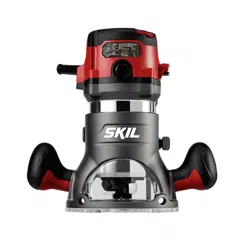Loading ...
Loading ...
Loading ...

19
Placing the Router onto the Workpiece and Starting the Cut
WARNING
Before operating the router follow all safety instructions in this manual.
Failure to do so could result in serious personal injury.
NOTICE:
Making test cuts is essential with most routing applications. A test cut will give a
feel for the set-up, the router’s speed, the depth of cut, and how the cutter bit reacts to the
workpiece.
Much of routing is a trial-and-error process of making various adjustments, followed by test
cuts. To avoid ruining good material, make your test cuts on scrap materials.
How you place your router onto a workpiece (starting the cut) with a xed base depends on
the type of routing you are going to produce: edge routing or internal routing, as discussed on
the following pages.
For ease of operation and to maintain proper control, your router has two handles: one on
each side of the router base. When operating the router, always hold it rmly with both hands.
WARNING
Always be alert and watch what you are doing. Never operate the router
when you are fatigued.
Deep Cuts
The proper cutting depth for each pass is always determined by the material, the cutter bit
size and type, and power of the motor.
Always make several progressively deeper cuts: start at one depth and then make several
passes, each time increasing the cutting depth, until your desired depth is reached.
Making a cut that is too deep will stress the router motor and the cutter bit, and it may burn the
workpiece and dull the cutter bit. It could also “grab” too much of the workpiece and cause you
to lose of control of the router, causing a serious accident.
To be certain that your depth settings are correct, always make test cuts in scrap material
similar to your workpiece before beginning the nal cutting operation.
Remember, knowing the right depth for each cut comes with routing experience.
Edge Routing (Fig. 12)
1. With the depth-of-cut set, place the router on
the edge of workpiece, making sure that the
cutter does not contact the workpiece.
2. Clamp an edge guide (board or metal
straightedge) in place to help guide the
router base.
3. Turn the router “On”, and allow the motor to
reach the selected speed.
4. To begin your cut, gradually feed the cutter
bit into the edge of the workpiece.
5. When the cut is complete, turn motor “Off”
and allow cutter bit come to a complete stop
before removing it from the workpiece.
6. Unplug the router from the power source, and inspect the nished cut in the workpiece.
WARNING
Always securely clamp your workpiece and keep a rm grip on the router
base with both hands at all times. Failure to do so could result in loss of
control, causing possibly serious personal injury.
Fig. 12
Edge
Guide
Remove Arrow
Edging with
Fixed Base
Loading ...
Loading ...
Loading ...
